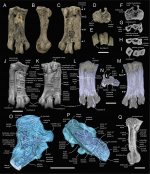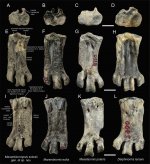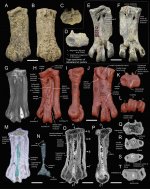Fred Ruhe
Well-known member

Piotr Jadwiszczak, Marcelo Reguero & Thomas Mörs, 2021
A new small-sized penguin from the late Eocene of Seymour Island with additional material of Mesetaornis polaris
GFF. Online edition. doi:10.1080/11035897.2021.1900385
Free pdf: https://www.tandfonline.com/doi/pdf/10.1080/11035897.2021.1900385?needAccess=true
Abstract:
Here, we report on two tarsometatarsi assignable to relatively small-sized Eocene Antarctic penguins, housed in the palaeozoological collections of Naturhistoriska riksmuseet, Stockholm. The Priabonian fossils were collected by museum staff during two joined Argentinean and Swedish expeditions from the Submeseta Formation on Seymour Island, Antarctic Peninsula. One specimen represents a new early sphenisciform, Marambiornopsis sobrali gen. et sp. nov., the sixth small-sized tarsometatarsus-based penguin species known from the Antarctic Eocene. Micro-CT scanning revealed the presence of quite large and essentially empty metatarsal medullary cavities. The second fossil can unequivocally be assigned to Mesetaornis polaris. The specimen represents only the second record of this species and supposedly a relatively young bird. Micro-CT scanning showed that in M. polaris the metatarsal medullary cavities are less developed than in M. sobrali – the cortical and trabecular bone tissues left rather little room for significant hollow spaces. Both specimens also differ in overall density of their trabecular networks.
Enjoy,
Fred
A new small-sized penguin from the late Eocene of Seymour Island with additional material of Mesetaornis polaris
GFF. Online edition. doi:10.1080/11035897.2021.1900385
Free pdf: https://www.tandfonline.com/doi/pdf/10.1080/11035897.2021.1900385?needAccess=true
Abstract:
Here, we report on two tarsometatarsi assignable to relatively small-sized Eocene Antarctic penguins, housed in the palaeozoological collections of Naturhistoriska riksmuseet, Stockholm. The Priabonian fossils were collected by museum staff during two joined Argentinean and Swedish expeditions from the Submeseta Formation on Seymour Island, Antarctic Peninsula. One specimen represents a new early sphenisciform, Marambiornopsis sobrali gen. et sp. nov., the sixth small-sized tarsometatarsus-based penguin species known from the Antarctic Eocene. Micro-CT scanning revealed the presence of quite large and essentially empty metatarsal medullary cavities. The second fossil can unequivocally be assigned to Mesetaornis polaris. The specimen represents only the second record of this species and supposedly a relatively young bird. Micro-CT scanning showed that in M. polaris the metatarsal medullary cavities are less developed than in M. sobrali – the cortical and trabecular bone tissues left rather little room for significant hollow spaces. Both specimens also differ in overall density of their trabecular networks.
Enjoy,
Fred






